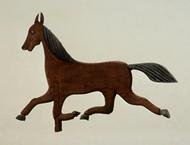
|
Horse Weather Vane Rendered by Lloyd Broome (artist), probably 1938 watercolor, graphite, colored pencil, and gouache on paperboard overall: 27.8 x 28 cm (10 15/16 x 11 in.) Index of American Design 1943.8.8048 |
Object 18 of 26
Certain wooden household articles were related functionally. Weathervanes, designed to adorn the roof of a house and to move with the wind, were akin to whirligigs. The latter also functioned as toys. Weathervanes, among the first meteorological instruments, have been a part of American folk art for more than 300 years. While many were made of metal, a large number were also of wood, providing one of the earliest avenues of expression for the woodcarver's art in America. The first American weathervanes were probably used on churches and were frequently in the shape of roosters -- a reference to Christ's warning that Peter would deny him before the cock crowed twice. But flourishing farm life in the nineteenth century prompted the adoption of many diverse silhouettes. Running-horse weathervanes were popular. Some were fashioned after Currier and Ives prints, but this one is somewhat more unusual. While interesting texture is added through the repeated grooves of mane and tail, the artist has concentrated on uninhibited, flowing contours. The most important aspect of a weathervane, indeed, was its silhouette, since it would be viewed from a distance against the sky.
| « | back to gallery | » | continue tour |


